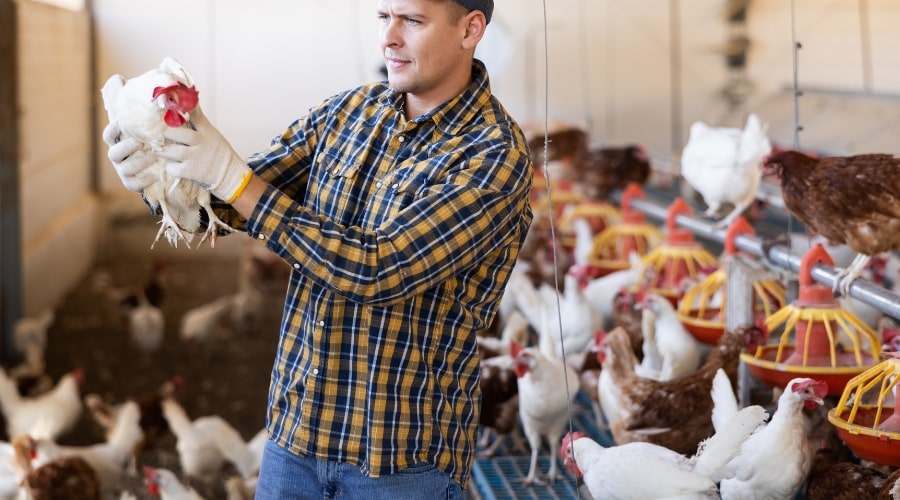Starting a poultry farm requires careful budgeting. Understanding the initial costs can help you plan effectively and avoid surprises. Here’s how to calculate your startup expenses when you’re new to poultry farming.
Land and Infrastructure Costs
If you don’t already own land, purchasing or leasing property is a significant expense. Choose land with good accessibility, drainage, and proximity to markets. The cost of land varies widely depending on location and size [TO BE VERIFIED].
Building poultry housing is another major cost. Structures must provide shelter, ventilation, and protection from predators. Costs depend on the type of system you choose:
- Free-range systems: Require fencing and larger spaces, which increase material costs.
- Intensive systems: Need specialized housing with controlled environments, which may include insulation and automated systems.
Add the cost of basic utilities like electricity and water connections if they aren’t already available on-site.
Purchasing Poultry and Equipment
The number of birds you start with determines your initial stock cost. For beginners, starting with 50 to 500 birds is common. Expect to pay more for high-quality or vaccinated chicks. Research prices from reputable hatcheries to get an accurate estimate [TO BE VERIFIED].
Essential equipment includes feeders, drinkers, and brooding systems. Automatic feeders and drinkers cost more but save time and reduce labor. Brooding systems, such as heaters or lamps, are necessary to maintain chicks’ body temperature during their first weeks.
Feed and Nutrition Costs
Feed is a recurring expense but must be accounted for in startup planning. Chicks require starter feed, which is nutrient-dense and slightly costlier. As they grow, you’ll transition to grower and layer feed (for layers) or finisher feed (for broilers).
Estimate the daily feed requirement based on the number and type of birds. For example, broilers consume more feed per day compared to layers. Include costs for any feed storage solutions like bins or silos to maintain freshness.
Health and Vaccination Expenses
Keeping your flock healthy prevents losses and ensures productivity. Vaccinations for diseases like Newcastle disease and avian influenza are essential. Initial costs include purchasing vaccines, syringes, and consulting with a veterinarian. These costs vary based on the breed and location [TO BE VERIFIED].
Include funds for biosecurity measures, such as disinfectants, footbaths, and protective clothing. Regular health checks help catch issues early and avoid expensive treatments.
Labor and Operational Costs
Labor costs depend on the size of your operation. If you’re starting small, you may handle daily tasks yourself. For larger farms, hiring workers for feeding, cleaning, and monitoring may be necessary.
Other operational costs include fuel for transportation, office supplies, and maintenance for equipment and housing. These ongoing costs should be estimated to avoid under-budgeting.
Miscellaneous and Unexpected Costs
Set aside a portion of your budget for unexpected expenses. These might include repairs, emergency veterinary care, or price fluctuations in feed or chicks.
Consider costs for permits and licenses required to operate your farm legally. These vary by region and type of farming system [TO BE VERIFIED]. Marketing and branding expenses, such as packaging for eggs or meat, also fall under this category.
Sample Cost Breakdown
Here is a general breakdown of potential startup costs:
- Land and housing: $5,000 to $20,000 [TO BE VERIFIED]
- Poultry stock: $2 to $5 per chick, depending on breed [TO BE VERIFIED]
- Feed and equipment: $1,000 to $5,000 for initial setup [TO BE VERIFIED]
- Health and biosecurity: $500 to $2,000 [TO BE VERIFIED]
- Labor and miscellaneous: $1,000 to $3,000 [TO BE VERIFIED]
Your actual costs will vary based on your farm size, location, and specific choices.
Creating a Budget Plan
Write a detailed budget listing all expenses. Use estimates from local suppliers to ensure accuracy. Divide your budget into fixed costs (housing, equipment) and variable costs (feed, labor). This helps you manage your finances more effectively.
Start small and scale up gradually. Smaller farms have lower startup costs and are easier to manage. Once you gain experience, you can reinvest profits to expand your operation.


